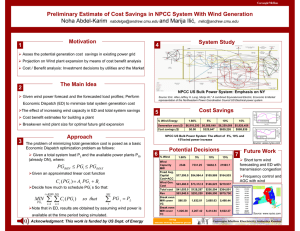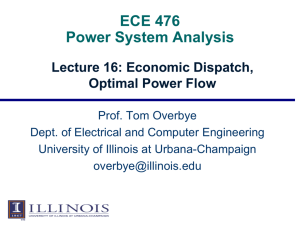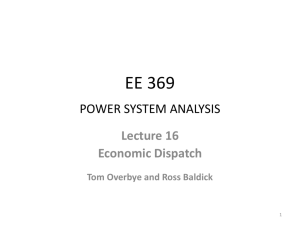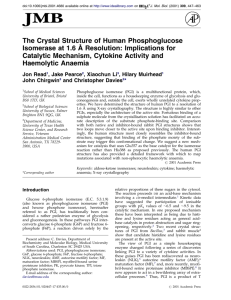Index Terms
advertisement
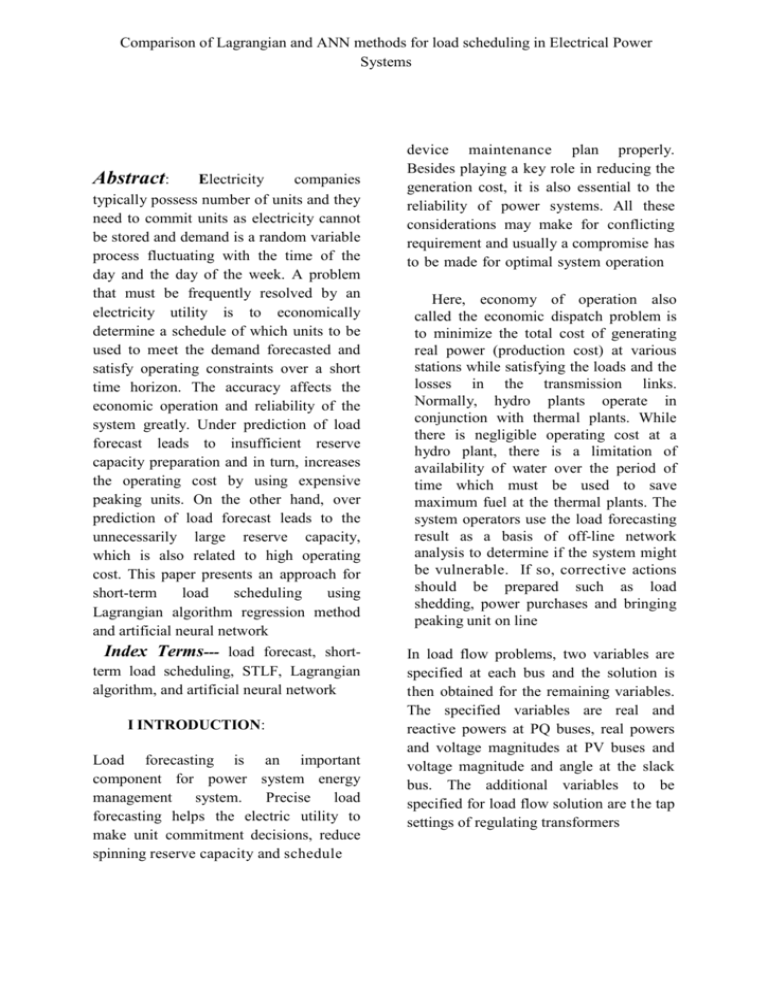
Comparison of Lagrangian and ANN methods for load scheduling in Electrical Power Systems Abstract: Electricity companies typically possess number of units and they need to commit units as electricity cannot be stored and demand is a random variable process fluctuating with the time of the day and the day of the week. A problem that must be frequently resolved by an electricity utility is to economically determine a schedule of which units to be used to meet the demand forecasted and satisfy operating constraints over a short time horizon. The accuracy affects the economic operation and reliability of the system greatly. Under prediction of load forecast leads to insufficient reserve capacity preparation and in turn, increases the operating cost by using expensive peaking units. On the other hand, over prediction of load forecast leads to the unnecessarily large reserve capacity, which is also related to high operating cost. This paper presents an approach for short-term load scheduling using Lagrangian algorithm regression method and artificial neural network Index Terms--- load forecast, shortterm load scheduling, STLF, Lagrangian algorithm, and artificial neural network I INTRODUCTION: Load forecasting is an important component for power system energy management system. Precise load forecasting helps the electric utility to make unit commitment decisions, reduce spinning reserve capacity and schedule device maintenance plan properly. Besides playing a key role in reducing the generation cost, it is also essential to the reliability of power systems. All these considerations may make for conflicting requirement and usually a compromise has to be made for optimal system operation Here, economy of operation also called the economic dispatch problem is to minimize the total cost of generating real power (production cost) at various stations while satisfying the loads and the losses in the transmission links. Normally, hydro plants operate in conjunction with thermal plants. While there is negligible operating cost at a hydro plant, there is a limitation of availability of water over the period of time which must be used to save maximum fuel at the thermal plants. The system operators use the load forecasting result as a basis of off-line network analysis to determine if the system might be vulnerable. If so, corrective actions should be prepared such as load shedding, power purchases and bringing peaking unit on line In load flow problems, two variables are specified at each bus and the solution is then obtained for the remaining variables. The specified variables are real and reactive powers at PQ buses, real powers and voltage magnitudes at PV buses and voltage magnitude and angle at the slack bus. The additional variables to be specified for load flow solution are t he tap settings of regulating transformers If the specified variables are allowed to vary in a region constrained by practical consideration(upper and lower limit on active and reactive generations bus ,voltage limits, and range of transformer tap settings)there results an infinite number of load flow solutions, each pertaining to one set of values of specified variables. The best choice in some sense of the values of specified variables leads to the best load flow solution. The first problem in power system is called the 'Unit Commitment (UC ) problem and the second is called the 'Load Scheduling' (LS) problem. One must first solve the UC problem before proceeding with the LS problem. LM has been successfully applied to the complex UC problem including various hard constraints (e.g. Ramp rate constraints, m i n i m u m u p a n d d o w n time, e t c .). Lagrangian relaxation with evolutionary programming and quadratic programming (LREQP) for ramp rate constrained unit commitment (RUC) problem is one of the most successful approaches. Most of the developed methods can be broadly categorized into three groups, namely parametric, nonparametric, and artificial intelligence based methods. In the parametric methods, a mathematical or statistical relationship is developed between the load and the factors affecting it. Some examples of these models are time functions, polynomial functions, linear regressions, Fourier series. In time-series methods, the load is treated as a time series signal, with known periodicity such as seasonal, weekly, or daily. Such repetitive cycle gives a rough prediction of the load at the given season, day of the week, and time of the day. The difference between the estimated and actual load can be considered as a stochastic process, which can be then analyzed using Kalman- Filter methods. Nonparametric methods forecast the load directly from historical data. II Optimal Operation of Generating Units Mathematical formulation Generator Operating Cost of The major component of generator operating cost is the fuel input/hour, while maintenance contributes only to a small extent. The fuel cost is meaningful in the case of thermal and nuclear stations, but for hydro stations where the energy storage is 'apparently free’; the operating cost as such is not meaningful. We concentrate on fuel fired stations. Fig 1: Input-output curve of a generating unit The input-output curve of a unit can be expressed in a million kilocalories per hour or directly in terms of rupees per hour versus output in megawatts. The cost curve can be determined experimentally. A typical curve is shown in Fig. 1 where (MW)min is the minimum loading limit below which it is uneconomical (or may be technically infeasible) to operate the unit and (MW)max is the maximum outpu t limit. The input-output curve has discontinuities at steam valve openings which have not been indicated in the figure. By fitting a suitable degree polynomial, an analytical expression for operating cost can be written as Ci(PGi )Rs/Hour at output PGi where the suffix i stands for the unit number. It generally suffices to fit a second degree polynomial degree to represent IC curve in the inverse form PGi= Ai+Bi(ICi)+Ci(ICi)2 Formulation Operation of -------(3) Optimal Let us assume that it is known a priori which generators are to run to meet a particular load demand on the station Ci(PGi) =1/2ai PGi2+ bPGi +di Rs/Hr----(1) ∑ PGi,max≥Pd The slope of the cost curve is dCi/d PGi, called the incremental fuel cost(IC) and is expressed in units of rupees per megawatt hour (Rs/MWh).A typical plot of incremental fuel cost versus power output is shown in Fig.2.If the cost curve is approximated as a quadratic as in Eq. (1), we have where PGi,max,is the rated real power capacity of the ith generator and Pd is the total power demand on the station. Further, the load on each generator is to be constrained within lower and upper limits, i.e (IC)i=ai Pgi + bi Considerations of spinning reserve require that --------(2) -------(4) PGi,min≤PGi,≤PGi,max where i=1,2……k -------(5) ∑PGi,max>Pd by proper margin ----(6) Fig.2: Incremental fuel cost versus power output for the unit whose input-output curve is shown in Fig.1 i.e. a linear relationship. For better accuracy incremental fuel cost may be expressed by a number of short line segments (piecewise linearization). Alternatively, we can fit a polynomial of suitable Since the operating cost is insensitive to reactive loading of a generator, the manner in which the reactive load of the station is shared among various online generators does not affect the operating economy. The question that has now to be answered is: 'Wh at is the optimal manner in which the load demand Pd must be shared by the generators on the bus keeping SC constraint optimized?' This is answered by minimizing the operating cost C= ∑Ci(PGi) +SC under the equality constraint of meeting the load demand i,e ∑PGi – Pd=0 -------- (7) Where k = the number of generators on the bus Further, the loading of each generator is constrained by the inequality constraint of Eq. (3). Since Ci(PGi) is non-linear and C, is independent of PGj, this is a separable non-linear programming problem. Lagrangian Algorithm 1)µ=∑Ci(PGi) - £(∑PGi – Pd) 1) Choose trial value of £ i.e, IC=(IC)0 2) solve for PGi from eq.(4) 3) If │∑PGi - Pd│< €(a specified value)the optimal solution is reached Otherwise, 4) 4)Increment IC by ∆(IC) │∑PGi - Pd│< € or decrement IC by ∆(IC), If │∑PGi - Pd│>0 And repeat from step 2 This step is possible because PGi is monotonically increasing function of (IC) Effect of equality constraint Where £ is langrangian multiplier 2)Minimization is achieved by d µ /dPGi=0; or dCi/dPGi=£; i=1,2…..k where dCi/dPGi is the incremental cost of ith generator(Units=Rs/MWh), a function of generator loading P Gi dC1/dPG1= dC2/dPG2... dCi/dPGi=£--(8) i,e. the optimal loading of generators corresponds to the equal incremental cost point of all the generators. Eq.(8) is called the co-ordinate equations numbering k are solved simultaneously with the load demand equation(4) to yield a solution for the lagrangian multiplier £ and the optimal loading of k generators Flow Chart for Computer Simulation using Lagrangian Algorithm As IC is increased or decreased in iterative process, if a particular generator loading reaches its P Gimax or PGimin, its loading from now on is held fixed at this value and the balance load is shared between remaining units based on equal IC basis. ANN METHOD Most of the conventional ANN-based load forecasting methods deals with 24hour-ahead load forecasting or next day peak load forecasting by using forecasted temperature. The drawback of this method is that when rapid changes in temperature of the forecasted day occur, load power changes significantly, which leads to high forecast error. In addition, conventional neural networks use all similar Dayís data throughout the training process. However, training of the neural networks using all similar Dayís data is a complex task and it does not suit learning of neural network. In the above fig. input signal are represented by X, Y is hidden layer V, W is the interconnection between input layer and hidden layer and Z is the output layer. In depends largely on the proper selection case of STLF, the performance of the forecast of the load affecting variables. In STLF, the key variables are time, forecasted weather variables, and historical load. Therefore, it is vital to identify the input variables, which have significant impacts on the system load. This is particularly important since inclusion of irrelevant inputs or inputs with no significant impact on the target outputs can distort the forecast performance, increase the training time, increase network complexity and reduce the network execution time. One approach to identify the most affecting input variables are by evaluating the statistical correlation between such input variables and the target output. In this paper, the linear correlation coefficient index is calculated between each input variable and the output target. Correlation coefficient with absolute values near 1 implies a high influence of an input variable to the target output. INPUT VARIABLES It is vital to identify the input variables, which have significant impacts on the system load. This is particularly important since inclusion of irrelevant inputs or inputs with no significant impact on the target outputs can distort the forecast performance, increase the training time, increase network complexity and reduce the work execution time. In case of STLF, the performance of the forecast depends largely on the proper selection of the load affecting variables. In STLF, the key variables are time, forecasted weather variables, and historical load. Therefore, in this approach, the forecast time interval is taken to be one hour i.e. forecast is done for each hour. Therefore, it is assumed that the hourly values of the weather parameters can capture the most conservative conditions that may happen during this hour. TRAINING DATA Training is the process by which ANN determines the different network parameters such as weights and biases. In general, the training data set should cover a wide range of input patterns sufficient enough to train the network to recognize and predict the relationship between input variables and target output. Typically, ANNs are trained following a supervised pattern, i.e. the desired output is given for each input and the training process then adjusts the weights and biases to match the desired output. A new method for selecting the training vector is presented in this paper. In this method, the minimum distance between the forecasted input variable and its desired outcome is calculated for the entire historical database. NETWORK TOPOLOGY In theory, a two-layer feed forward network can be used for predictions. For the number of neurons in each layer are 10 and 20, the number of units in the input and output layers are fixed by the number of inputs and the number of outputs, respectively. Since the target output is the forecasted hourly load, the model has one output representing the forecasted load of the target hour. Due to seasonal load variations, four case studies, related to the different four seasons are performed. The number of inputs for each case is dependent on the number of the effective parameters as determined by the correlation analysis. One of the challenges in the design of ANN is the proper selection of the number of neurons in the hidden layer, which affects the learning capability and varies by the complexity of the problem. In general, a tradeoff between accuracy and generalization ability can be achieved by selecting the proper number of hidden units. While, there is no rigorous set of rules to determine the optimal number of hidden units, the fundamental rule is to select the minimum number of hidden neurons just enough to ensure the complexity of the problem, but not too many to cause over fitting of the training set and losing generalization ability. b) Self-Organization: An ANN can create its own organization or representation of the information it receives during learning time. c) Real Time Operation: ANN c o m p u t a t i o n s ma y b e carried out in parallel, and special hardware devices are being designed and manufactured which take advantage of this capability. The method starts by setting the estimated optimal number of hidden neurons as the square root of the product of the number of inputs times the number of the outputs. Then the number of hidden neurons is gradually incremented by one. The parameters of three layer artificial neural network for 24 hour ahead load forecasting are as given below: No. of layers: 3 (Input layer, Hidden layer, Output layer) No of neurons in hidden layer: 10 to 20 No of neurons in output layer: 1 Activation function of hidden layer: logsig Activation function of output layer: Linear Training algorithm: BackPropagation Learning rate (·): 0.1 APPLICATIONS a) Adaptive learning: An ability to learn how to do tasks based on the data given for training or initial experience. No of data sets in each epoch: 63 No. of epochs for training: 100 NEURAL NETWORK (MATLAB) numHiddenNeurons = 50; % adjust as desired net = newfit(inputs,targets,numHidde nNeurons); net.divideParam.trainRatio = 80/100; net.divideParam.valRatio = 10/100; net.divideParam.testRatio = 10/100; % Train and Apply Network [net,tr] = train(net,inputs,targets); outputs = sim(net,inputs); % Plot plotperf(tr) plotfit(net,inputs,targets) plotregression(targets,outputs) . VI. CONCLUSION (I) Lagrangian with all coupling constraints penalized can provide better scheduling results as it can detect inbetween-hours shutdown of some units, earlier shutdown, and/or later startup of some other units (II) Main advantages of using NNs are • its capability of dealing with stochastic variations of the scheduled operating point with increasing data • Very fast and on-line processing and classification • Implicit nonlinear modeling and filtering of system data However, NNs for power system should be viewed as an additional tool instead of a replacement for conventional or other AI based power system techniques. Currently NNs rely on conventional simulations in order to produce training vectors and analysis the training vectors, especially with noisy data. There are some remain major challenge to be tackled using NNs for power system: training time, selection of training vector, upgrading of trained neural nets and integration of technologies. REFERENCES 1. Meyer, W.W. and V.D. Albertson, .Improved Loss Formula computation by optimally ordered Enumeration Techniques', IEEE Transmp As, 1971,9 0:716. 2. Agarwal, S'K. and I.J' Nagrath," Optimal Scheduling of Hydrothermal Systems, Proc. IEEE, 1972, 199: 169. 3. Aytb, A'K' and A.D. Patton, "Optimal Thermal Generating Unit Commitment, IEEE Trans., JulyAug 1971, pAS_90: 1752. 4. J.Y. Fan, J.D. McDonald, ëA realtime implementation of short ñ term load forecasting for distribution power systemsí, IEEE Transactions on Power Systems, 1994, 9, 988 ñ 994. 5. Wenjin Dai , ping Wang ëApplication of Pattern Recognition and Artificial Neural Network to Load Forecasting in Electric Power System. 6. A.A. Desouky, M.M. Elkateb, hybrid adaptive techniques 7. M. M. Tripathi, K. G. Upadhyay, S. N. Singh, Short-Term Load Forecasting using Generalized Regression and Probabilistic Neural Networks in the Electricity Market, The Electricity, Volume 21, Issue 9, November 2008, pp 24-34 8. M. Nakamura ñ Short Term Load Forecasting Using Weekday Load Models and Bias Models; Proc. PICA Conference, 1984, pp. 3742. 9. Abdul-Rahman, K. H.; Shahidehpour, S. M.; Aganaic, M.; and Mokhtari, S., A practical resource scheduling with OPF constraints. IEEE Trans. Power Systems 11(1): 254259, 1996. 10. Kothari, D.p., "Optimal Hydrothermal Scheduling and Unit commitment,. Ph. D. Thesis, B.I.T.S, Pilani, 1975. 11. Kirchmayer,L .K., Economic operation of Power systems” J, ohn wiley, Newyork,Peterson, W. L. and Brammer, “A capacity based Lagrangian relaxation unit commitment with ramp rate constraints”, IEEE Trans. On Power Systems 10(2): 1077-1084 12. S.E.Skarman, M.Georgiopoulous, ëShort-term electrical load forecasting using a fuzzy ARTMAP neural networkí, Proceedings of the SPIE, (1998), 181 - 191.


